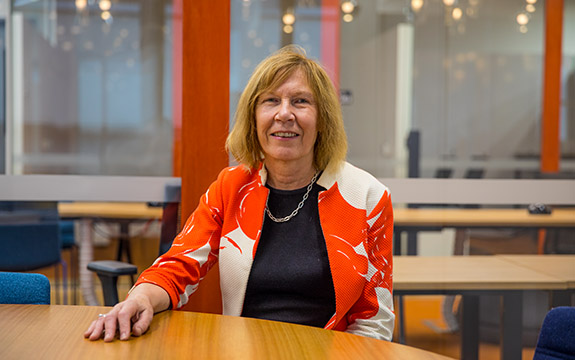Dr Elaine Saunders leads the charge for digital health and innovation at Swinburne

In Summary
- Dr Saunders is Chair of Swinburne’s Innovation Precinct Advisory Board
- She is a co-founder of Blamey Saunders Hears and helped revolutionise the hearing aid industry
- She says training people in remote health will benefit everyone
Growing up, Swinburne’s Dr Elaine Saunders watched as her father struggled with hearing loss, something that led her to a lifetime of helping others with hearing problems. She started out volunteering at a school for the deaf in her youth. Decades later she is a leader in the hearing and health community, and has improved the quality of life for many with hearing impairments.
Dr Saunders joined Swinburne in 2015 as an Adjunct Professor. This year, she has become more involved in the Swinburne community as Chair of the Innovation Precinct Advisory Board, where she provides advice based on her experience in innovation, health and entrepreneurship.
Out of her passion for the hearing impaired community, Dr Saunders completed a science degree, a clinical audiology degree and finally a PhD in biomedical engineering - all leading her to co-found Blamey Saunders Hears. The company’s goal is to overcome the barriers preventing millions of Australians from finding a hearing solution - things like cost and lack of access to audiology services.
“We saw that hearing health needed to reach more people at a lower price and with better service,” says Dr Saunders. She and the team delivered a shake-up of the hearing aid industry with a combination of remote hearing testing (teleaudiology) and face-to-face service to better accommodate people from all backgrounds.
The public is ready for better health
Dr Saunders’ experience in setting up Blamey Saunders Hears showed her that the public can handle new models of healthcare delivery and are willing to use existing and emerging technologies.
“The public is absolutely ready for it. They’re ready for health in the home. Almost everyone has a smartphone,” she says of the public’s growing technology literacy. The trouble is that remote healthcare and embedding digital capabilities is still relatively new to most clinical professions according to Dr Saunders.
“It will be a challenge, as most clinicians think in a traditional way,” she says. “Swinburne has taken a tremendous step in saying, ‘yes’ to digital health and it’s really being led here.”
The key to addressing these problems isn’t ‘tweaking the old models’, but looking for completely new ways to address them. “Today in Industry 4.0, we can think differently and we can do it differently,’ says Dr Saunders.
“We can train people in remote health and it will benefit everyone,” she says. “It will benefit the existing profession, benefit the patients, clients - it ticks all the boxes.”
Doing disruption right
Dr Saunders says that while she was considered a disrupter when she started making waves in the hearing community, she's now acting more like an adviser to healthcare’s future, saying that you need to break ground while also bringing people along with you on the journey.
“All the hearing aid companies are following Blamey Saunders Hears now,” she says. “Yes, we’ve changed the world, but, if you’re really too disruptive and too offensive, then you’ll get squashed.
“We’ve really been careful to prioritise good clinical outcomes,” she says. “So while we’ve been disruptive, our objectives have been very, very true to the consumer’s needs.”
She says you can’t be too impatient in health and that if you really want to make lasting change in the world, it must be through an academic institution.
Guiding Swinburne’s innovation journey
In her roles as Chair of the Innovation Precinct Advisory Board and member of the course advisory committee for Swinburne’s new Graduate Certificate of Teleaudiology, Dr Saunders hopes to aid in Swinburne’s goal of global social impact.
“My biggest role is certainly helping with the strategy of the Innovation Precinct,” she says. “Being based on campus I will also be available as a mentor to young companies and entrepreneurs.”
She says that Swinburne is very well placed to show leadership in innovation and looks forward to guiding the university.
“The initiatives that have started here and the staff that have been put here are doing a good job in moving towards the future, and I want to make sure the strategy makes a global and social impact.”

